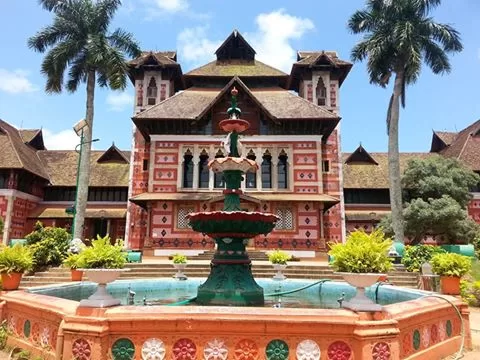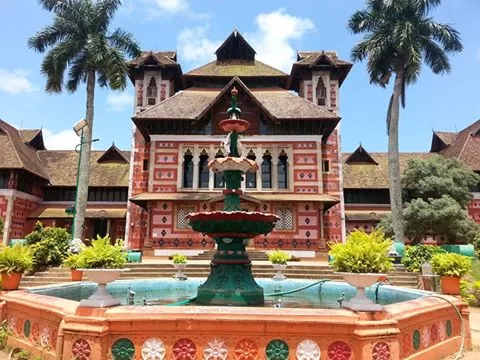Profile
Introduction
The Sree Padmanabhaswamy Temple, nestled within the East Fort of Thiruvananthapuram, Kerala, India, is renowned for its opulence, architectural splendor, and spiritual significance. Dedicated to Lord Vishnu, reclining on the serpent Anantha, this temple is not only a religious landmark but also a cultural and architectural marvel.
Historical Background
The origins of Sree Padmanabhaswamy Temple date back to antiquity, shrouded in myth and legend. Believed to be one of the 108 Divya Desams (sacred abodes of Vishnu), its historical records trace to ancient texts like the Puranas. Significant renovations by Marthanda Varma, a prominent Travancore king in the 18th century, transformed the temple into its present grandeur.
Padmanabhaswamy Temple is believed to be around 5000 years old, though the present structure was rebuilt in the 17th century by Raja Marthanda Varma, a ruler of Travancore. The temple is dedicated to Lord Vishnu in the form of Padmanabha (Lotus-Navel).
Legends and historical records suggest the temple’s origin dates back several millennia, with significant renovations and additions made during various periods of history.
Key Features and Highlights
The temple’s architecture blends Kerala and Dravidian styles, characterized by its towering gopuram (pagoda) and the intricate stone carvings that adorn its exterior. Inside, the sanctum sanctorum houses a massive idol of Lord Vishnu reclining on Anantha, crafted from a complex amalgam of 12008 salagramams. The temple’s grandeur extends to its 80-foot-high gold-plated flagstaff and the exquisite murals depicting various Hindu deities.
Things to Do
- Witness Rituals: Experience the early morning Nirmalya Darshanam and participate in the evening Pooja ceremonies.
- Explore Architecture: Admire the temple’s structural features like the Navagraha Mandapa and the ornate corridors with 365 carved granite pillars.
- Attend Festivals: Join the Murajapam and Bhadra Deepam festivals held periodically, which include vibrant processions and cultural performances.
Visitor Information
- Opening Hours:
- Morning: 3:30 AM – 12:00 PM
- Evening: 5:00 PM – 7:20 PM (Timings subject to change during festivals)
- Entry Fee: Free (Donations accepted)
- Dress Code: Strict dress code for men (dhoti) and women (sari or skirt/blouse).
- Accessibility: Limited accessibility for differently-abled; assistance available upon request.
How to Get There
- By Air: Nearest airport is Trivandrum International Airport, about 6 km away.
- By Train: Trivandrum Central Railway Station is 1.5 km from the temple.
- By Road: Well-connected by local buses and taxis; ample parking available near the East Fort.
Nearby Attractions
- Napier Museum and Art Gallery: Explore Kerala’s rich cultural heritage and art collections.
- Kuthira Malika (Puthen Malika) Palace: Visit the former royal residence known for its exquisite wood carvings.
- Shanghumukham Beach: Relax at this serene beach offering stunning sunsets and local cuisine.
Travel Tips
- Respect Local Customs: Follow temple etiquette and respect Hindu rituals.
- Clothing: Carry or rent appropriate attire if not wearing traditional dress.
- Local Cuisine: Taste authentic Kerala dishes like appam, stew, and seafood delicacies.
- Safety: Be cautious with personal belongings in crowded areas; beware of tourist scams.
For those planning to visit the Padmanabhaswamy Temple in Trivandrum (Thiruvananthapuram), here are the details you need to know about entry fees and other important information:
Entry Fee:
- Special Darshan: ₹150 per person
- Special Darshan with Prashad: ₹180 per person
Temple Timings:
- The temple opens early in the morning around 3 AM for rituals.
- Darshan timings are as follows:
- Morning Darshan: 3:15 AM to 4:15 AM (Nirmalya Darshanam)
- Regular Darshan: 6:30 AM to 7 AM, 8:30 AM to 10 AM, 10:30 AM to 11:10 AM, and 11:45 AM to 12 PM
- Evening Darshan: 5 PM to 6:15 PM (except on certain special occasions)
Dress Code:
- Men: Traditional attire like mundu (dhoti) with or without angavastram (shawl)
- Women: Saree, skirt (long or mid-length) with blouse, mundu with blouse, or salwar kameez with dupatta
- Children: Boys should wear mundu or dhoti with or without angavastram, and girls can wear saree, skirt and blouse, or salwar kameez with dupatta
Important Notes:
- Photography: Photography and videography inside the temple premises are strictly prohibited.
- Mobile Phones: It’s recommended to keep mobile phones switched off or in silent mode during the visit.
- Footwear: Footwear is not allowed inside the temple premises. There are facilities to deposit your footwear securely outside the temple.
Temple Architecture and Significance:
- The Padmanabhaswamy Temple is renowned for its blend of Kerala and Dravidian architectural styles.
- It houses a 100-foot tall gopuram (ornate entrance gate) and features exquisite stone carvings and sculptures.
- The main deity, Lord Padmanabha, lies in a reclining posture on Adi Shesha (thousand-hooded serpent), with three doors through which devotees can view different parts of the idol.
- The temple features Dravidian style architecture with a massive gopuram (gateway tower) adorned with intricate carvings and sculptures depicting various mythological themes.
Treasure of Padmanabhaswamy Temple:
- The temple’s vaults, especially vault A, have been the subject of considerable interest due to the immense wealth and precious artifacts stored within.
- Vault B remains unopened, surrounded by myths and beliefs about its protection by mystical forces.
Other Attractions:
- Ottakkal Mandapam, Abhisravana Mandapam, Kulasekhara Mandapam, and Padmatheertham pond are notable features within the temple complex.
- The temple also hosts various shrines dedicated to other deities like Narasimha and Krishna.
Visiting the Padmanabhaswamy Temple offers not just a spiritual experience but also a glimpse into centuries of history, art, and cultural richness.
Padmanabhaswamy Temple, located in Trivandrum, Kerala, is renowned for its historical significance, architectural beauty, and religious practices deeply rooted in Hindu traditions. Here’s a detailed overview of the temple, its history, rituals, festivals, entry details, and more:
Special Poojas and Offerings: Various special rituals and poojas are conducted at specific times. For example, Nirmalyam to Deeparadhana and other rituals have designated timings and costs associated with them.
Festivals Celebrated
Major Festivals:
- Alpasi Utsavam: Held in October/November, featuring special processions (sreebali) with decorated vahanas (vehicles of deities).
- Painkuni Utsavam: Celebrated in March/April with Kodiyettu (flag hoisting) ceremony and other rituals.
- Thiruvonam: Celebrated as the birthday of Lord Padmanabha with special traditions.
Other Festivals: Includes Navarathri Pooja, Maha Shivarathri, Rama Navami, Vinayaka Chathurthi, and more.
Entry Details and Facilities
Entry Fee: Entry to the temple is free. Special darshan tickets are available for ₹150 or ₹180 (with prasad), and entry for two at ₹250 along with a pooja thali.
Visiting Hours: The temple is open during specific timings for darshan, and it’s advisable to arrive early to avoid long queues.
Facilities: Lockers are available for storing personal belongings like mobile phones and cameras as photography is prohibited inside the temple. Handbags are allowed.
FAQs
Treasure: The temple gained international attention for its treasure trove, though not all vaults have been opened yet.
Dress Code: Strictly followed to maintain the sanctity of the temple premises.
Best Time to Visit: Winter months (October to February) are recommended due to pleasant weather and festival celebrations.
Restrictions: Only Hindu devotees are allowed inside the temple premises.
Padmanabhaswamy Temple stands not only as a religious center but also as a cultural and architectural marvel, attracting devotees and tourists alike to witness its grandeur and spiritual significance.
The Sree Padmanabhaswamy Temple stands not only as a testament to Kerala’s rich cultural heritage but also as a spiritual oasis for devotees and tourists alike. Plan your visit to immerse yourself in the divine aura and architectural splendor of this ancient temple, where history, myth, and spirituality converge.
Plan your visit today and discover the mystical charm of Sree Padmanabhaswamy Temple in the heart of Thiruvananthapuram, Kerala, India.
Map
Sorry, no records were found. Please adjust your search criteria and try again.
Sorry, unable to load the Maps API.




